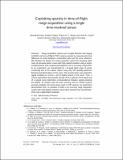Exploiting sparsity in time-of-flight range acquisition using a single time-resolved sensor
Author(s)
Kirmani, Ahmed; Colaco, Andrea B.; Wong, Franco N. C.; Goyal, Vivek K.
DownloadGoyal_Exploiting sparsity.pdf (3.025Mb)
PUBLISHER_POLICY
Publisher Policy
Article is made available in accordance with the publisher's policy and may be subject to US copyright law. Please refer to the publisher's site for terms of use.
Terms of use
Metadata
Show full item recordAbstract
Range acquisition systems such as light detection and ranging (LIDAR) and time-of-flight (TOF) cameras operate by measuring the time difference of arrival between a transmitted pulse and the scene reflection. We introduce the design of a range acquisition system for acquiring depth maps of piecewise-planar scenes with high spatial resolution using a single, omnidirectional, time-resolved photodetector and no scanning components. In our experiment, we reconstructed 64 × 64-pixel depth maps of scenes comprising two to four planar shapes using only 205 spatially-patterned, femtosecond illuminations of the scene. The reconstruction uses parametric signal modeling to recover a set of depths present in the scene. Then, a convex optimization that exploits sparsity of the Laplacian of the depth map of a typical scene determines correspondences between spatial positions and depths. In contrast with 2D laser scanning used in LIDAR systems and low-resolution 2D sensor arrays used in TOF cameras, our experiment demonstrates that it is possible to build a non-scanning range acquisition system with high spatial resolution using only a standard, low-cost photodetector and a spatial light modulator.
Date issued
2011-10Department
Massachusetts Institute of Technology. Department of Electrical Engineering and Computer Science; Massachusetts Institute of Technology. Research Laboratory of Electronics; Program in Media Arts and Sciences (Massachusetts Institute of Technology)Journal
Optics Express
Publisher
Optical Society of America
Citation
Kirmani, Ahmed et al. “Exploiting Sparsity in Time-of-flight Range Acquisition Using a Single Time-resolved Sensor.” Optics Express 19.22 (2011): 21485. © 2011 Optical Society of America
Version: Final published version
ISSN
1094-4087